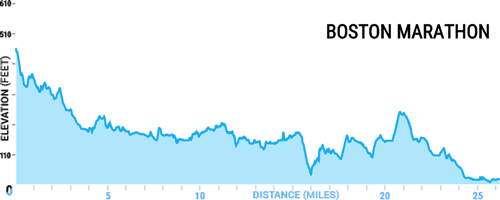When runners think about the Boston Marathon, a few iconic landmarks come to mind: the screaming college students at Wellesley, the Citgo sign during the final couple miles, and Heartbreak Hill. Of these landmarks, Heartbreak Hill strikes fear in even the most seasoned runners. As its name suggests, Heartbreak Hill is where race day dreams can be broken.
Thankfully, you can train for Heartbreak Hill and not have your heart broken at the Boston Marathon. Follow these tips for how to train for Heartbreak Hill – or any hilly marathon!

Finish Your Long Runs on Hills
The Newton hills earn the moniker “Heartbreak” not because of their incline, but because of when they occur in the race. Heartbreak Hill appears just around the 20 mile mark, which is also the point in the race when many runners hit “the wall” and bonk.
No matter the race course, you will be tired 20 miles into a marathon. But you can prepare your body and your mind to handle those hills when your legs are tired by simulating the same conditions in training. On long runs of 18-22 miles, run the last few miles on a hilly route. The hills don’t need to be incredibly steep – most of the Newton hills have only a 3-4% incline – and focus on maintaining an even effort rather than trying to maintain your pace.
If you don’t live in a hilly area, you can get creative. Do a majority of your long run outside, then hop on a treadmill and set it at 3-4% for the final 2 miles. You could also run stairs or along a bridge (if you can safely do so) to mimic hills.
Do Marathon Pace Runs on Rolling Hills
If you want to run a certain goal time at the Boston Marathon, you want to do more than just train for Heartbreak Hill; you want to train for maintaining your goal race pace over Heartbreak Hill and the other Newton hills.
Every few weeks in your training, do a run at your marathon goal race pace on rolling hills. Practice maintaining an even effort (not pace) as you climb up the hills and run down them. Focus on maintaining a quick turnover of your feet and an upright posture on the hills, always looking ahead rather than down at your feet. This will teach you how to sustain that pace over hills while also training you not to sprint the downhill or bust your lungs on the uphill.
Strength Train Once to Twice Per Week
Strength training consistently throughout marathon training will strengthen your legs and prevent you from fatiguing on Boston’s hills. You don’t need to take up CrossFit or do power lifting; a few simple strength training exercises will strengthen your glutes, quads, core, and upper body for strong hill running.
Try this routine once or twice per week to prepare your body for Boston’s (or any race’s) hills. Use dumbbells, a medicine ball, or a kettlebell that’s just heavy enough to make the last rep challenging. If strength training is not part of your normal routine, do these exercises without weights to begin. Marathon training is hard enough on the body, so you don’t want to push too hard in strength training.
- 2 x 20 weighted squats
- 2 x 30 second side planks
- 2 x 15 push ups
- 2 x 12 weighted reverse lunges (per leg)
- 2 x 15 weighted step ups
- 2 x 20 glute bridges
- 2 x 15 bent over rows
- 2 x 30 second wall sits
Develop and Practice a Pacing Strategy
The Boston Marathon course begins with a downhill stretch. This downhill is the reason why many runners struggle over Heartbreak Hill – they run the downhill stretch too quickly, thus fatiguing their legs early on and increasing their likelihood of bonking right as they approach the hill. Downhill running can have up to three times the impact as flat running and starting out any marathon too fast will burn you out by the final 10K.
So word to the wise…don’t start out too fast on Boston. You cannot use the early downhill to bank time for the Newton hills – this strategy never works in a marathon. Instead of sprinting down the descent of the first couple miles, use the decline to help you ease into race pace. You will conserve energy for later in the race and save your legs for the final 10K with all of its hills.
By following these tips, you can run a strong and enjoyable Boston Marathon – from start through Heartbreak Hill all the way into Boston until you turn right on Hereford and left on Boylston and finish #BostonStrong.

